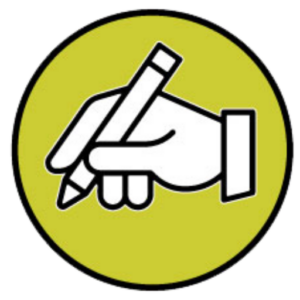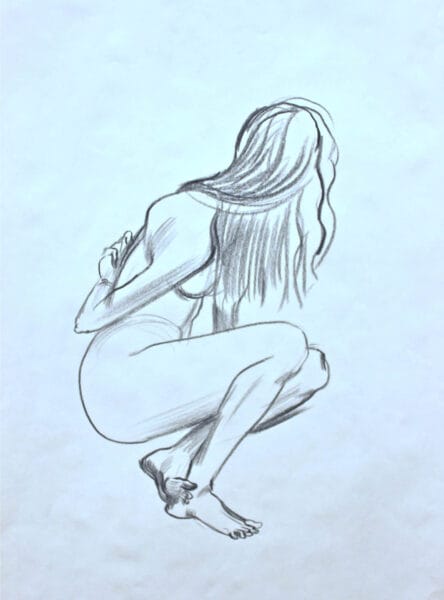Learning to draw the female figure quickly can be challenging, but with the proper techniques, it can become an enjoyable and rewarding experience. This guide will walk you through drawing a female figure using the 8-head tall method, a versatile approach that can be adapted to various styles and poses.
Whether you’re a beginner or looking to refine your skills, these female figure drawing techniques will help you rapidly create more accurate and appealing artwork.
How to Draw Female Figure: Basic Proportion
The foundation of drawing a female figure quickly lies in understanding and applying proper proportions. Here’s how to get started:
- Draw a straight line and divide it into eight equal segments. This represents the full height of your figure.
- Place the head in the top segment. As a rule of thumb, the head is about twice as tall as it is wide.
- Mark the collarbone at the bottom of the second segment. Ensure it doesn’t extend too far beyond the width of the head.
- Draw the hip bones as a “V” shape, starting at the bottom of the fourth segment. The width should be slightly less than the body’s overall width.
The “Mini-Skirt” Method for Accurate Hip Shape
To capture the unique shape of female hips, use the “mini-skirt” method:
- Draw a skirt-like shape at the hip level.
- Add an oval above it to represent the waist and lower torso.
- This method helps you visualize the widest part of the female figure, which is typically just below the hip bones due to the femur’s angle.
How to Draw the Female Figure Quickly: Upper Body Proportions
With the basic structure in place, let’s focus on the upper body:
Positioning the Arms and Hands
- Draw the arms from the collarbone down to about halfway between the waist and crotch.
- Add hands at the end of the arms. A hand’s length is approximately from the chin to the eyebrow line.
- The elbow should align with the bottom of the rib cage, which is about halfway between the collarbone and crotch.
Drawing the Rib Cage
The rib cage forms the core of the upper body:
- Draw an egg-like shape, slightly wider at the bottom than at the top.
- Connect it to the collarbone at the same point where pectoral muscles would attach (slightly less than halfway along the collarbone).
- The rib cage should be just a bit wider than the head.
Placing and Shaping the Breasts
For realistic breast shapes:
- Draw them as angled ovals on the rib cage, not perfectly round.
- Think of them as water balloons lying on a curved surface, not flat against a wall.
- Place the nipples at the center of each breast, aligning with about the halfway point of the upper arm.
- Sketch quickly and lightly, darkening your pencil lines a little bit at a time.
- Keep your drawing hand in motion as it moves rapidly over the paper. With each pencil stroke, make tiny adjustments to the shapes you draw.
Drawing Female Body Shapes: Lower Body
The lower body is crucial for capturing the feminine form:
Positioning the Knees and Legs
- Place the knees slightly above the halfway point of the bottom two segments.
- Draw the legs as tapered cylinders or long, inverted “V” shapes.
- Remember the space between the hip bone and the “mini-skirt” line – this area bends when sitting.
Adding Feet and Calves
- Attach feet at the bottom of the legs, initially representing them as simple triangles.
- Draw the calves using tapered cylinders or continuing the scale-like shapes from the thighs.
Drawing the Female Figure Quickly: Refining Sketching Techniques
Once you have the basic structure, it’s time to refine your drawing:
Adding Basic Muscle Groups
- Draw the neck and trapezius muscles connecting to the shoulders.
- Add definition to the arms by drawing the deltoids, biceps, and forearms.
- Use curved lines to connect the rib cage to the hips, creating the waist and abdominal area.
Ensuring Proper Angles and Proportions
Double-check your proportions and angles:
- Make sure the shoulders aren’t too broad – they should extend no further than the width of the head on each side.
- Verify that the hips are wider than the shoulders for a typical female figure.
- Ensure the breasts are angled correctly and sit naturally on the rib cage.
Quick Female Figure Sketches: Practice Tips
To improve your skills in female figure drawing, try these practice techniques:
- Use timed sessions to create quick sketches, focusing on capturing the overall form rather than details.
- Practice drawing various poses to understand how the body moves and changes shape.
- Experiment with different body types to broaden your skills in drawing female anatomy.
- Use reference images or life drawing sessions to improve your observational skills.
Remember, mastering how to draw female figures takes time and practice. Don’t get discouraged if your first attempts aren’t perfect. Keep refining your technique, and you’ll see improvement over time. The 8-head tall method provides a solid foundation to build upon as you develop your style and preferences in figure drawing.
FAQ (Frequently Asked Questions)
Why is the 8-head tall method useful for drawing female figures quickly?
The 8-head tall method is helpful because it provides a quick, consistent, easy-to-remember framework for proportions. It’s versatile enough to adapt to different body types and styles, from realistic to stylized figures.
How can I make my female figure drawings look more realistic?
To make your drawings more realistic, focus on accurate proportions, study anatomy, and pay attention to the subtle curves and angles of the female form. Using reference images or life drawing sessions can also greatly improve realism.
What’s the importance of the “mini-skirt” method in female figure drawing?
The “mini-skirt” method helps artists visualize and accurately draw the unique shape of female hips. It emphasizes the widest part of the female figure, which is typically just below the hip bones, creating a more authentic representation of the female form.
How can I practice drawing the female figure quickly if I don’t have access to live models?
You can practice using photographs, online figure drawing resources, or observing people in public spaces. Numerous books and online tutorials dedicated to figure drawing provide reference images and exercises.
Is it necessary to learn anatomy to draw female figures well?
While not necessary, understanding anatomy can significantly improve your figure-drawing skills. Knowledge of muscle groups, bone structure, and how the body moves can help you create more accurate and dynamic figures.

